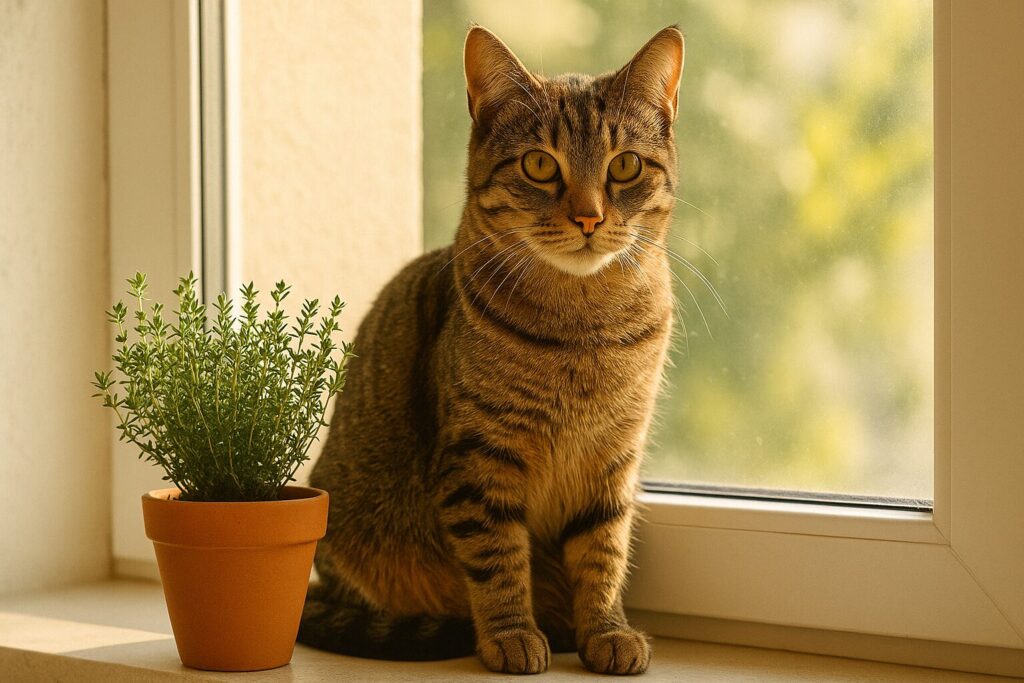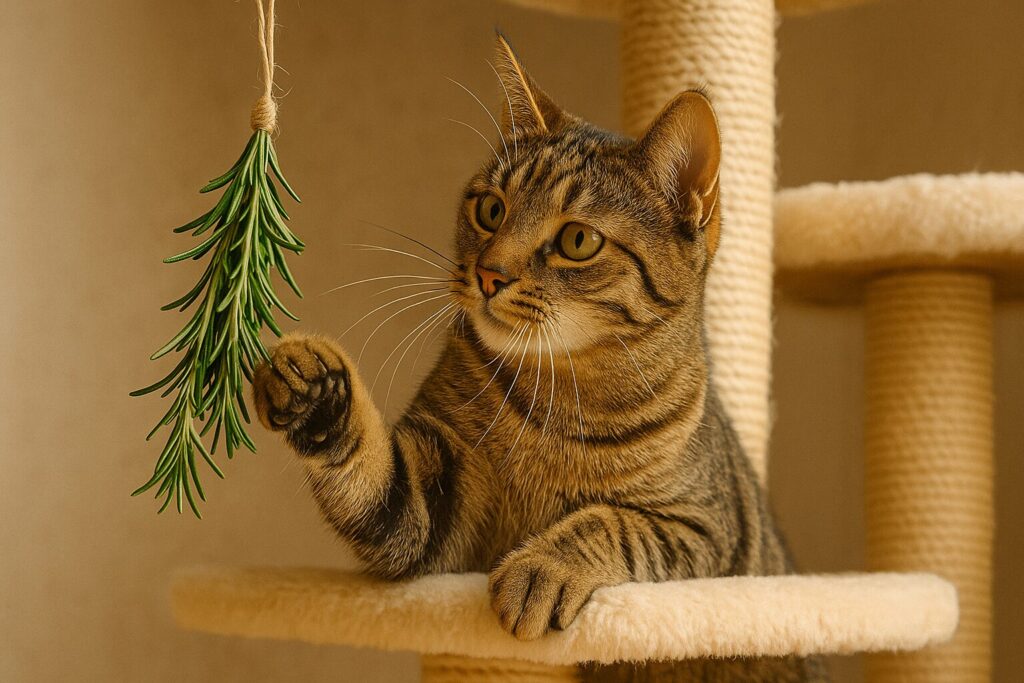Cats are curious creatures. Whether they’re leaping onto countertops, sniffing at your groceries, or investigating that new planter, their inquisitive noses are always on the move. In this post, I’ll show you how to use your cat’s natural instincts to provide hours of budget friendly enrichment with cat safe herbs you probably already have in your kitchen or garden.
Not all herbs are safe for cats. But luckily, there are several kitchen herbs that are both safe and beneficial for cats to sniff and nibble. Even better? These herbs can be used to provide sensory enrichment that helps keep your cat happy, stimulated, and relaxed. We’ll explore which herbs are feline-friendly, how to offer them to your cat, and creative ways to use them to enrich your cat’s environment.
Why Herb-Based Enrichment?
Cats experience the world through their senses. Incorporating cat safe herbs into their routine engages their sense of smell and taste, mimics behaviors they might have in nature, and encourages positive interaction with their environment.
Benefits include:
- Mental stimulation
- Reduced boredom and stress
- Opportunities for safe chewing and foraging
- A more natural, enriched home environment
Common Kitchen Cat Safe Herbs
Let’s take a closer look at some herbs that are generally considered safe for cats. Remember: moderation is key, and every cat is different. Start small and observe your cat’s reaction.
1. Catnip (Nepeta cataria)
Let’s start with the superstar. Catnip is famous for its ability to make cats roll, drool, zoom, and purr in delight. While not every cat is affected (about 30% feel nothing at all), for those who are sensitive, catnip can be an instant mood-lifter.
Enrichment Ideas:
- Dry some leaves and stuff them in a toy.
- Sprinkle a bit on a scratching post.
- Grow a pot indoors for fresh access.
2. Valerian Root (Valeriana officinalis)
Valerian root can have a similar effect to catnip, though its scent is stronger and more musky. Some cats go bonkers for it!
Enrichment Ideas:
- Place a pinch of dried root inside a sock or toy.
- Mix a bit into a foraging box.
3. Lemongrass (Cymbopogon citratus)
In small amounts, lemongrass is safe and often enjoyed by cats for its scent and texture. However, too much can cause stomach upset.
Enrichment Ideas:
- Place a lemongrass plant on a high shelf within sniffing (not chewing) range.
- Rub a leaf lightly on a favorite toy to transfer the scent.
4. Thyme (Thymus vulgaris)

Regular garden thyme (not wild thyme or Spanish thyme) is non-toxic to cats and has a savory, appealing aroma. Some cats love to rub against it or gently chew on the leaves.
Enrichment Ideas:
- Add a few sprigs to a cardboard box for a sniffable hideout.
- Let your cat graze from a thyme plant in a sunny window.
5. Basil (Ocimum basilicum)
While it may not send your cat into a frenzy like catnip, basil is perfectly safe for cats to nibble on. The scent alone can be stimulating.
Enrichment Ideas:
- Offer a fresh leaf for sniffing during grooming time.
- Place basil near a perch or window seat for gentle ambient aroma.
6. Parsley (Petroselinum crispum)
Parsley is a great source of vitamins and is safe in small quantities. Cats might nibble it for the fresh flavor or simply for fun.
Enrichment Ideas:
- Mix chopped parsley into your cat’s treat ball.
- Freeze chopped parsley with water into ice cubes for summer play.
7. Rosemary (Rosmarinus officinalis)

While not all cats enjoy rosemary’s piney scent, it is non-toxic and some cats find it interesting to sniff or paw at.
Enrichment Ideas:
- Hang a bundle in a cat-safe room for scent-based enrichment.
- Add a rosemary sprig to your cat’s favorite napping area to introduce new smells.
How to Offer Herbs Safely
Here are some general tips to keep enrichment safe and enjoyable:
- Supervise the first few interactions. Make sure your cat doesn’t overindulge or have a negative reaction.
- Offer herbs fresh or dried. Avoid essential oils—they’re too concentrated and may be toxic.
- Use untreated, pesticide-free plants. Organic is best if you’re buying from a store or nursery.
- Rotate herbs weekly. Novelty keeps your cat engaged and prevents boredom.
- Grow a cat-friendly herb garden. A sunny kitchen windowsill or a secure balcony space can be the perfect spot.
Warning: Not Cat Safe Herbs to Avoid
For safety, steer clear of these herbs which are toxic to cats:
- Oregano
- Mint (especially pennyroyal)
- Chives
- Garlic
- Onions
- Bay leaves
- Tarragon
- Sage (in large quantities)
When in doubt, check the ASPCA’s list of toxic and non-toxic plants or consult your veterinarian.
Final Thoughts: A Herb-Filled Life for Your Feline
Introducing cat safe herbs to your cat’s world is a simple, natural way to boost their happiness and provide much-needed sensory stimulation. Whether it’s the thrill of a catnip chase or the calming aroma of thyme by the window, herbs add variety and joy to your cat’s daily life.
So next time you’re chopping parsley, or pruning your basil or other cat safe herbs, set a sprig aside for your feline friend. With a bit of creativity and care, your kitchen garden might become your cat’s favorite playground.
Do you use herbs to enrich your cat’s life? Got a favorite sniff-worthy suggestion or a hilarious catnip story? Share it in the comments below! We’d love to hear from you.







Thanks for this fantastic post, I am glad I found your site on yahoo.